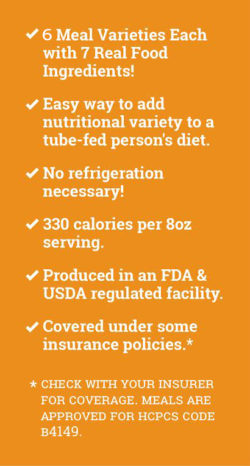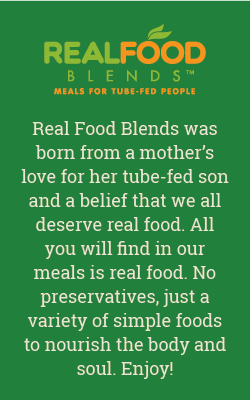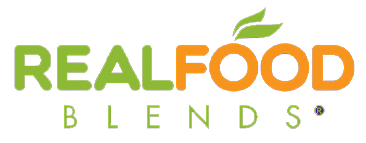Getting Started with Real Food Blends Meals
How do I use Real Food Blends meals?
As always, please consult with your medical professionals regarding any change in a tube-fed person’s diet.
Our meals are much thicker than formula, and are intended to be bolus fed with a syringe. If you would like a thinner blend, you can always add additional liquid (milks, coconut water, etc.)
Each pouch yields an 8 ounce serving (the measure on the front of the pouch is a weight measurement, not liquid. These are purees after all!)
The meals are best served at room temperature or slightly warmed. (If the meal is too cold, it will thicken!) If you would like to warm the meal, pour into a heat-safe container before you do so. Do not place the pouch directly in the microwave!
How do I start on Real Food Blends?
This question differs depending on your age, specific needs and condition. If you’re an adult who has eaten regular food your whole life, this isn’t a huge change (we’re just putting real food into real stomachs after all!) For those that have never had real food before, you’ll want to make sure there aren’t any allergy concerns. Usually, swapping out 1-2 cans of formula with 1-2 Real Food Blends meals per day works well to start. More tips are here and here.
Are Real Food Blends meals only for children/adults?
No! Our meals can be used by anyone with a feeding tube over the age of 1–we’re just talking about real food after all! Kids and adults who are oral eaters have foods like chicken, brown rice, and squash and that’s all that’s in Real Food Blends. Consult your medical team to determine how many of our meals to consume each day for your individual nutritional and caloric needs–you can find complete nutritional information for each of our meals here.
Why are the meals so thick?
These are meals, not formula, so they are much thicker and intended to be bolus fed through a syringe. This thickness is intentional. Thicker meals tend to ‘sit better’ in a stomach than a 100% liquid meal – some find that thicker meals seem to help with reflux as well. (If you’re not tube-fed yourself, think back to when you’ve had a liquid meal before and how it just ‘sloshes around’ in your stomach. Not very satisfying, right?) The thickness also helps us pack the nutrition into fewer ounces. When developing these meals, we figured that one could always add more liquid if a thinner consistency was desired, but not vice versa!
Won’t the tube clog?
We aren’t permitted to 100% guarantee the meals won’t clog a tube due to a variety of reasons (manufacturing variances, user error, etc.) These meals were created in a USDA / FDA regulated facility and with any large-scale production, some particulant matter may occur. We can assure you that we have tested these meals with a 14-french tube using a 60 mL syringe and had no problem with the tubes clogging. Be sure to flush the tube often and don’t let food (or formula for that matter!) sit in the tube. If you’re concerned about clogging, have a tube that you can’t easily change out if a clog were to occur, or have a small tube, you can add some liquid to the blend and strain before using.
Can the meals be used in a J-tube?
This is a better question for your medical team if you have a jejunostomy tube and the answer really depends on the reason you have a J-tube and not a G-tube. If your medical team has approved, we always recommend that you thin out the meals with some additional liquid and strain to be extra cautious when using a J-tube.
We're only using a small serving for now. Can I freeze the meals?
Yes! Meals that have already been opened can be frozen. Be aware that freezing meals can change the consistency a bit upon thawing. Adding some warm water or another liquid may help.
What is the hang time for each meal?
After opening, please enjoy Real Food Blends meals within a two hour timeframe, or refrigerate any unused portion before that. Although the hang time can technically vary depending on when you’re using the meals (i.e. middle of summer vs. a cold winter day), we prefer to be extra cautious to avoid any potentials for food-borne illnesses. (Our meals ONLY contain real food–no additives or preservatives to extend hang times. Would you want to eat chicken that had been sitting out for 2+ hours?)
What is the serving size?
This is sort of a complicated question as our meals are purees – not pure liquid – and the outside label states “9.4 ounces.” This is a weight measurement, not a liquid volume measure, which is different than typical formulas.
Each meal yields an 8 ounce (by liquid measure) serving and the nutritional label on the back of the meals reflects this / using the entire pouch. Confusing, we know!
Help! My meals froze/were exposed to hot weather!
All Real Food Blends meals are shelf stable for three years from the date of manufacture when stored at ambient room temperature. If the meals are exposed to extreme temperatures, don’t worry, they are still safe to use as long as the pouch has remained intact! (There can be some degradation of the nutrient profile if meals are exposed to both freezing and hot temperatures repeatedly or this can also shorten the shelf-life somewhat.) Cold temperatures (including freezing) can cause the consistency of our meals to change and some separation to occur. You have a few options if this happens:
– Run the unopened pouch under warm running water and shake/massage the pouch to reincorporate the separated ingredients.
– Mix in additional liquid (you can do this directly in the pouch, in a blender bottle, or in a standard kitchen blender.)
– Gently warm the meals in a heat-safe container. We find that emerging the unopened pouch into hot water works well, too. Just make sure to not feed a meal that’s TOO hot – or too cold for that matter. Room temperature or slightly warm typically feels best in the stomach.
Exposure to high temperatures for short periods of time should not impact the meals greatly but expect some degradation of the nutrient profile if the meals have been in a hot temperature for weeks or months.
If you have any questions or concerns, don’t hesitate to contact us.
Ordering and Shipping
How do I buy Real Food Blends?
Online right here. You can also purchase via Amazon.com. You do not need a prescription for our meals however we recommend talking to your medical team before making changes to your enteral regime.
Will my insurance cover Real Food Blends?
It’s likely! Insurance coverage varies across the board but you can start by calling your current home health care company (DME) and asking for our meals. Sometimes it’s that easy! We have much more information here and you can always call one of our DME partners as well.
How are the meals shipped? How fast?
We make every effort to ship the meals from one of our two warehouses the very next business day after an order is placed. Most orders will ship UPS Ground and arrive within 5 business days. Expedited shipping is available at an additional cost by calling our office at 1-888-484-9495. Cases of Real Food Blends are also available on Amazon, and expedited shipping is oftentimes cheaper through Amazon.
How much is shipping? Can you expedite?
Real Food Blends meals are shipped via UPS in most cases (we occasionally will utilize USPS if it’s a cheaper rate.) We ship from two warehouse locations and most orders will be received in 4-5 business days. Shipping rates for the continental US are as follows:
Trial pack = $5.95
1 case = $8.95
2 cases = $15.00
3 cases = $21.00
4-10 cases = $25.00
11 cases and more = $25.00 plus $5.00 per case
If you need the meals quicker, we can expedite for an additional fee. Please call our office at 1-888-484-9495 for pricing. Oftentimes, Amazon.com can ship faster and cheaper in these situations.
Can I return meals after I purchase them?
Unfortunately we are unable to accept returns due to the sensitive nature of this product (we would never resell meals to you that had been out of our control!). There are many Medical Supply Exchanges on Facebook where you can list the meals that you purchased directly from us for sale, as well as Ebay and Amazon. (Please note that if you received our meals covered by your insurance, you legally cannot resell the meals.) Donations can be made to the Parker Lee Project, too.
Ingredients
Are the meals Gluten Free?
We have not certified the meals as Gluten free as they are produced in a facility that handles gluten ingredients. However, our meals do NOT contain any raw ingredients with gluten – you can read the ingredient lists here. (The oats in our Salmon and Egg meals are now certified Gluten Free oats as of January 2016.)
Are your meals complete nutrition?
The same way that oral eaters need to eat a wide variety of foods over the course of a day or week to achieve necessary nutrient goals, our meals are just that – meals. They are each well-balanced and together offer a good variety. We developed these first meals with the intention that someone who is living off 6 or 8 cans of formula a day could easily add some nutritional variety to their diet with the addition of our meals. Those that already blenderize for tube-feeding can use our meals as a convenient option.
If you are using our meals as a sole source of nutrition (so getting nothing else), you will need to take an age-appropriate multivitamin and a dash of salt daily. Please discuss with your dietitian. If you take a look at the ingredients list in a can of regular formula, most of the ingredients are added vitamins to make them nutritionally complete – something you can easily do with a multi-vitamin.
Aside from nutritional variety, we hope that giving a few different meals to tube-fed people will have a positive psychological impact. These are meals similar to what the rest of the family is getting. (The last thing someone with a tube wants is to be further isolated or different!) Also, many tube-fed adults report that they can still experience some taste sensation through burping and smelling their food. Part of the reason some report disliking formula so much is regurgitation or smelling the same thing over and over again. This is why we have added a spice to some of our meals and hope that our customers enjoy the variety.
Read more about what “nutritionally complete” really means in our guest blog post from Alissa Rumsey MS, RD, CDN, CSCS.
The meals seem high in fat, why?
Well, yes! We purposefully increased the fat content of our meals in order to keep the calorie counts near the 40 calories per ounce goal. Many people with feeding tubes have ‘volume issues’ – meaning they need to be fed smaller meals throughout the day in order to reach their calorie goal. (One of the reported benefits of switching to a blenderized diet is that volume tolerance usually increases.)
Back to our meals. Because of the high heat process the meals need to go through in order to be shelf-stable, we needed to add more water, which meant we needed to add more fat to keep the calorie count where we wanted it. But fear not, this isn’t a bad thing! The fats in our meals are from fantastic sources: salmon, grapeseed oil, sunflower seeds, extra virgin olive oil, etc.
Our Registered Dietitian, Lara Field, says to keep these figures in mind for perspective:
1 avocado = 29 g fat
1/4 c walnuts = 19.5 g fat
3 oz salmon = 10 g fat
1 TBSP olive oil = 14 g fat
3 oz ground turkey = 12 g fat
Our hope is that you’ll love these first few meal options so we can make more – and more varieties with other sources of great fats!
Are the meals organic?
We consciously chose to not make these meals organic for a variety of reasons. First, we realize that many on a feeding tube have complex medical issues and the accompanying mounds of bills, so we wanted to keep our price per meal low. Also, the potential for insurers to cover organic meals was incredibly low. This was a major concern.
Secondly, our meals have to be exposed to high heat to be made shelf-stable without additives or preservatives. That high heat process does unfortunately kill some good ‘stuff’ while killing off any potential bad organisms. Our thought was any benefit one would get from having organics would be negligible after this process and not worth the additional costs.
All that being said, if you want an organic meal option and would be willing to pay the premium for that, please let us know on Facebook or Twitter. We are all ears to any and all feedback.
Where is the salmon from? How about the chicken?
The Salmon is a mix of Keta, Pink and Coho Salmon and is wild from Alaska, Canada, and the Pacific Northwest. The raw chicken is domestic and most comes from the southern United States. The ground beef in the Beef, Potatoes and Spinach meal is 100% grass-fed.
Why is there sometimes a difference in the consistency of the meals?
As with any real food product, variations in caloric and nutrient levels should be expected due to soil and weather conditions, and this can impact the consistency of our meals, as can room temperature and storage conditions. We have controls in place that allow for an acceptable range of consistency, so you may notice some variations from time-to-time.
If you’re placing an order during colder months, there is also the possibility that the meals can become partially frozen in transit, which can alter the consistency. As long as the pouch is still sealed/intact, they are safe to use. Please contact us if you have any specific concerns.







